City contours Jena
Life is bene in Jene
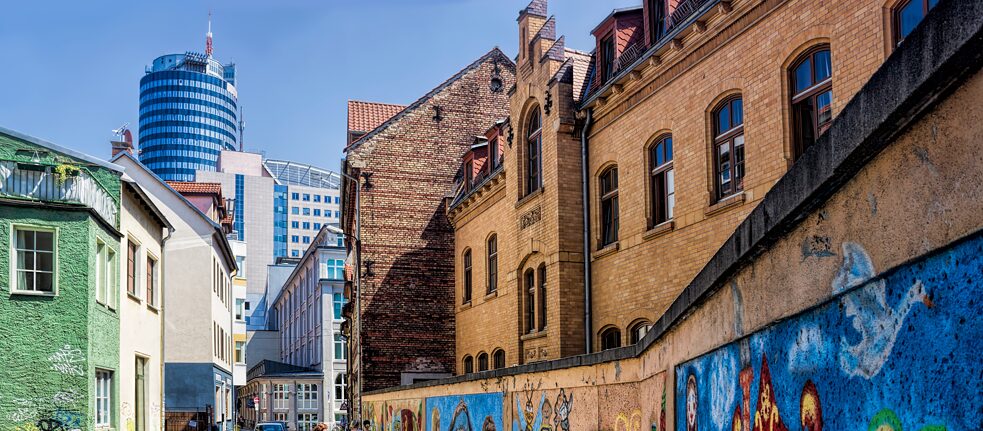
“Jena, that’s that prefab city,” is what the motorists speeding along the motorway past the huge, concrete apartment buildings from the GDR era say. If, however, you choose to travel to the Thuringian city on the River Saale by train, you will find yourself in the middle of a verdant paradise. Jena is ambivalent and utterly imperfect. Which is precisely why our author Nancy Droese finds her city so appealing.
By Nancy Droese
My telescope is from there
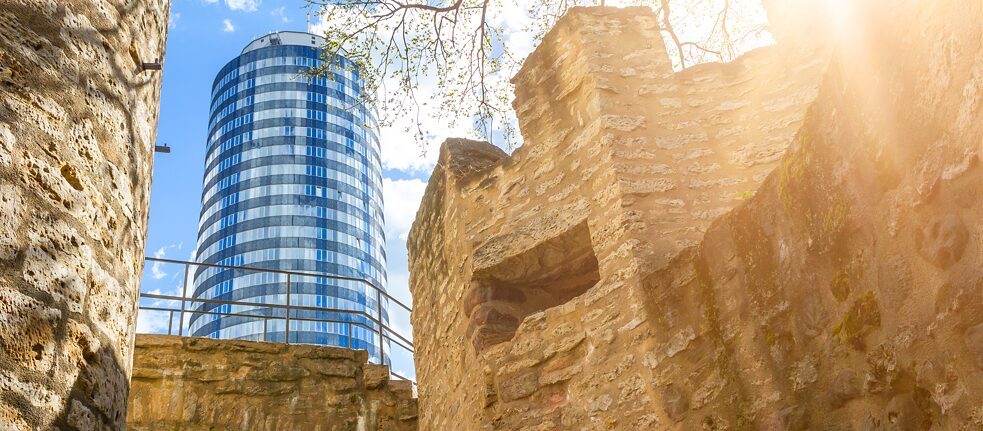 Built for the ZEISS company in the 1970s, today the Jentower is home to offices and a luxury hotel complete with gourmet restaurant on the top floors.
| Photo (detail): Adobe
Anyone from Jena knows the situation all too well: Someone asks, “Where are you from?” and the answer “Jena” generally results in bemused silence. Then you try to explain: “Have you heard of the Zeiss company?” Response: “Ah yes, of course, they made my camera lens!” Jena is considered the heart of the German optics and precision mechanics industry. It was home to Carl Zeiss, Ernst Abbe and Otto Schott – the ultimate triumvirate in optics and glass. Accordingly, the city is still closely intertwined with the industry today. Jena’s most visible landmark – the 144.5-meter-high, round Jentower – was built for the Zeiss company in the 1970s. Ultimately though, Zeiss never moved in because the high, glass, slightly undulating tower proved less than suitable for housing high-precision technology. Today, a number of companies have office space here, and visitors can stay in the luxury hotel complete with gourmet restaurant that occupies the upper floors. The public viewing platform on the 28th floor offers a fantastic view. You will sound like a knowledgeable insider if you refer to the building in the middle of downtown as the “biscuit roll”. Just a few minutes’ walk away is another spectacular 360° panoramic view in Germany’s longest-serving planetarium.
Built for the ZEISS company in the 1970s, today the Jentower is home to offices and a luxury hotel complete with gourmet restaurant on the top floors.
| Photo (detail): Adobe
Anyone from Jena knows the situation all too well: Someone asks, “Where are you from?” and the answer “Jena” generally results in bemused silence. Then you try to explain: “Have you heard of the Zeiss company?” Response: “Ah yes, of course, they made my camera lens!” Jena is considered the heart of the German optics and precision mechanics industry. It was home to Carl Zeiss, Ernst Abbe and Otto Schott – the ultimate triumvirate in optics and glass. Accordingly, the city is still closely intertwined with the industry today. Jena’s most visible landmark – the 144.5-meter-high, round Jentower – was built for the Zeiss company in the 1970s. Ultimately though, Zeiss never moved in because the high, glass, slightly undulating tower proved less than suitable for housing high-precision technology. Today, a number of companies have office space here, and visitors can stay in the luxury hotel complete with gourmet restaurant that occupies the upper floors. The public viewing platform on the 28th floor offers a fantastic view. You will sound like a knowledgeable insider if you refer to the building in the middle of downtown as the “biscuit roll”. Just a few minutes’ walk away is another spectacular 360° panoramic view in Germany’s longest-serving planetarium.
The city next door to Weimar
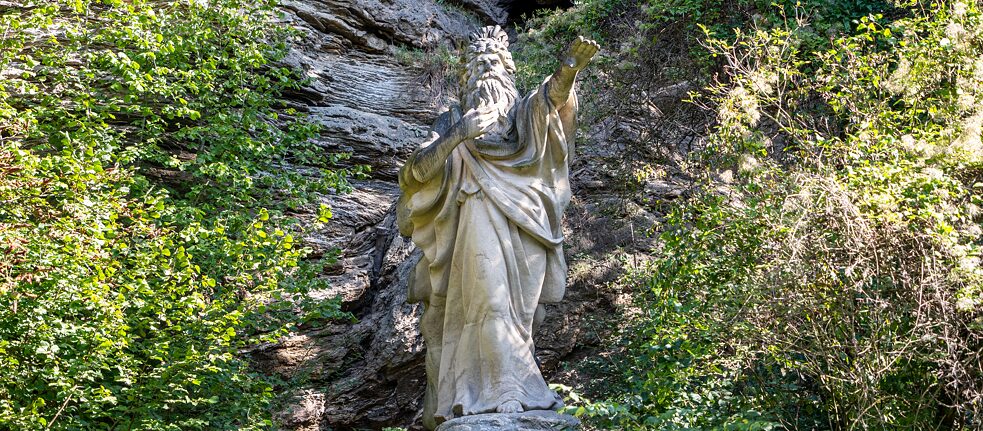 “O, who rides by night thro’ the woodland so wild?” Jena commemorated the Erl-King from Johann Wolfgang von Goethe’s eponymous poem with a statue.
| Photo (detail): Adobe
It takes a trained eye to see the signs that Jena was once a stronghold of poets and thinkers as you walk through the city. It has long since ceded the “city of the classics” title to neighbouring Weimar. But the list of commemorative plaques is long, as the true “Who’s Who” of the intellectual scene enjoyed hanging out here in the 1800s. Goethe spent a lot of free time in Jena – in part, wicked tongues would have it, to escape staid Weimar and his wife – and invited Schiller to join him. Today, countless white enamel signs on the walls of Jena’s buildings indicate who else was around then, such as Romantics Johann Gottlieb Fichte, Georg Wilhelm Friedrich Hegel, Ludwig Feuerbach, Friedrich Wilhelm Joseph Schelling and Christoph Wilhelm Hufeland and from the circle of early Romantics Ludwig Tieck, the Schlegel brothers, Caroline Schlegel, Dorothea Veit and many more. The “Göhre” city museum is a good place to learn more. The Romantics also have their own museum in the “Romantikerhaus”, as does Schiller, whose garden house bears witness to the life and work of the poet the university was named after. The imposing statue of the “Erlkönig” (Erl-King) at the edge of a romantic pond a bit outside the Ostviertel in the east is another reminder of grandmaster Goethe.
“O, who rides by night thro’ the woodland so wild?” Jena commemorated the Erl-King from Johann Wolfgang von Goethe’s eponymous poem with a statue.
| Photo (detail): Adobe
It takes a trained eye to see the signs that Jena was once a stronghold of poets and thinkers as you walk through the city. It has long since ceded the “city of the classics” title to neighbouring Weimar. But the list of commemorative plaques is long, as the true “Who’s Who” of the intellectual scene enjoyed hanging out here in the 1800s. Goethe spent a lot of free time in Jena – in part, wicked tongues would have it, to escape staid Weimar and his wife – and invited Schiller to join him. Today, countless white enamel signs on the walls of Jena’s buildings indicate who else was around then, such as Romantics Johann Gottlieb Fichte, Georg Wilhelm Friedrich Hegel, Ludwig Feuerbach, Friedrich Wilhelm Joseph Schelling and Christoph Wilhelm Hufeland and from the circle of early Romantics Ludwig Tieck, the Schlegel brothers, Caroline Schlegel, Dorothea Veit and many more. The “Göhre” city museum is a good place to learn more. The Romantics also have their own museum in the “Romantikerhaus”, as does Schiller, whose garden house bears witness to the life and work of the poet the university was named after. The imposing statue of the “Erlkönig” (Erl-King) at the edge of a romantic pond a bit outside the Ostviertel in the east is another reminder of grandmaster Goethe.
An alleyway of enchantment
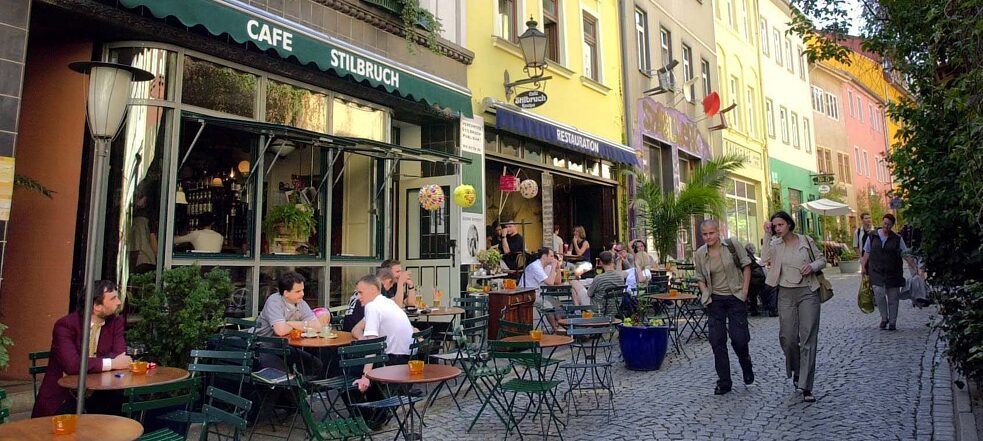 Flair and foodie culture among historic buildings: the Wagnergasse in Jena.
| Photo (detail): © picture alliance/ZB/Jan-Peter Kasper
Wagnergasse is to Jena as the famous Diagon Alley is to Harry Potter: the undisputed heart of Jena’s pub scene. The narrow, cobblestoned, 300-meter-long historic alleyway features some equally historic buildings that were spared from the mania of soulless post-reunification renovation, and around 15 individual bars, cafés, restaurants and smaller shops crowd the area. “Stilbruch” restaurant is the cornerstone and quasi founder of Wagnergasse as a pub mile. A true spatial wonder, its narrow, artfully forged spiral staircase extends over three floors. The menu is bursting with homemade, fresh creations, so there is virtually no need to ever leave the table from breakfast to an evening nightcap. No wonder numerous patrons choose the pub as a meeting place. Those looking for a quick bite, on the other hand, stop off at the “Fritz Mitte” snack bar. Be forewarned though: The long queue in front of the octagonal kiosk is notorious.
Flair and foodie culture among historic buildings: the Wagnergasse in Jena.
| Photo (detail): © picture alliance/ZB/Jan-Peter Kasper
Wagnergasse is to Jena as the famous Diagon Alley is to Harry Potter: the undisputed heart of Jena’s pub scene. The narrow, cobblestoned, 300-meter-long historic alleyway features some equally historic buildings that were spared from the mania of soulless post-reunification renovation, and around 15 individual bars, cafés, restaurants and smaller shops crowd the area. “Stilbruch” restaurant is the cornerstone and quasi founder of Wagnergasse as a pub mile. A true spatial wonder, its narrow, artfully forged spiral staircase extends over three floors. The menu is bursting with homemade, fresh creations, so there is virtually no need to ever leave the table from breakfast to an evening nightcap. No wonder numerous patrons choose the pub as a meeting place. Those looking for a quick bite, on the other hand, stop off at the “Fritz Mitte” snack bar. Be forewarned though: The long queue in front of the octagonal kiosk is notorious.
Club culture with long arms
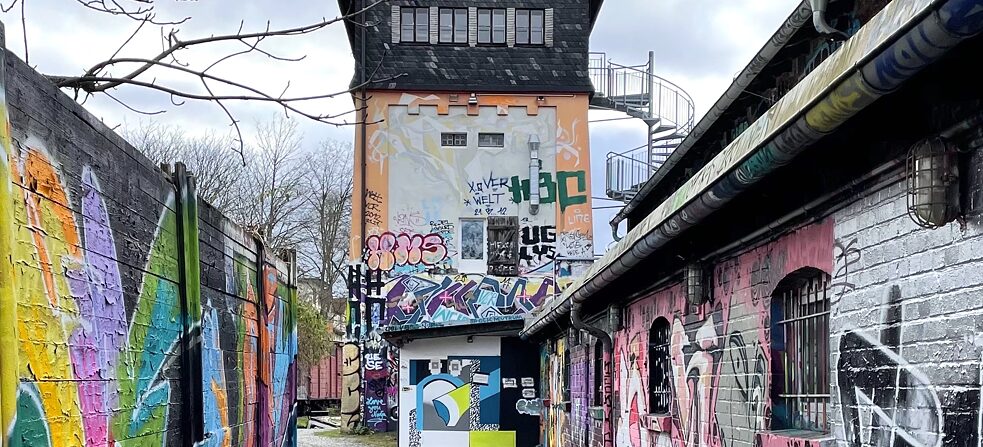 Decorated with colourful graffiti: Jena’s best-known club, the Kassablanca.
| Photo (detail): © Kassablanca Jena
Jena’s best-known club, the Kassablanca or Kassa for short, is a combination of an old water tower, a former locomotive shed, and several train cars – all of which have been decorated with colourful graffiti to create a work of art. Near the Westbahnhof station, the club has been Jena’s centre of subculture for three decades, a launch pad for artists, and the spiritual home of numerous creative types. Generations have sweated through their shirts here and celebrated their music and, yes, their attitude towards life. Almost every musical genre, apart from mainstream radio hits, is represented here. To this day though, electronic music has pride of place at the “Kassa”. Thomas Sperling is one aficionado who has been on board almost since day one. Known as the “Sparrow” to his friends, he also founded the “Freude Am Tanzen” and “Musik Krause” labels popular in the Jena scene and is the power behind the well-stocked “Fatplastics” record store in Schillergäßchen, thus dropping a pin for Jena in the electronic music map.
Decorated with colourful graffiti: Jena’s best-known club, the Kassablanca.
| Photo (detail): © Kassablanca Jena
Jena’s best-known club, the Kassablanca or Kassa for short, is a combination of an old water tower, a former locomotive shed, and several train cars – all of which have been decorated with colourful graffiti to create a work of art. Near the Westbahnhof station, the club has been Jena’s centre of subculture for three decades, a launch pad for artists, and the spiritual home of numerous creative types. Generations have sweated through their shirts here and celebrated their music and, yes, their attitude towards life. Almost every musical genre, apart from mainstream radio hits, is represented here. To this day though, electronic music has pride of place at the “Kassa”. Thomas Sperling is one aficionado who has been on board almost since day one. Known as the “Sparrow” to his friends, he also founded the “Freude Am Tanzen” and “Musik Krause” labels popular in the Jena scene and is the power behind the well-stocked “Fatplastics” record store in Schillergäßchen, thus dropping a pin for Jena in the electronic music map.
There really is an arena
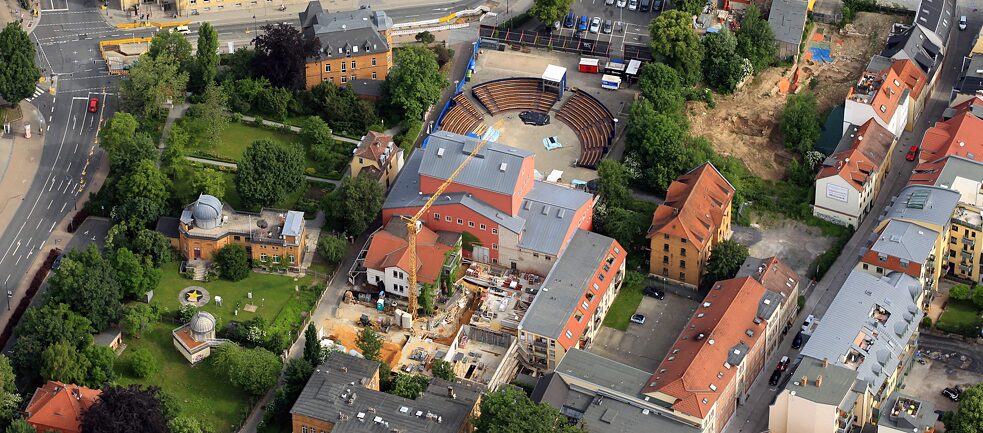 Not an antique amphitheatre, but an arena nonetheless: the Kulturarena in Jena.
| Photo (detail): © picture alliance/ZB/euroluftbild.de/Karina Hessland
Although Jena does not have an arena in the sense of an ancient amphitheatre, you will hear the term bandied about constantly. The Kulturarena – a seven-week international open-air festival for theatre, music and film in the middle of the city – is a summer fixture. Fittingly, the Kulturarena has another drama to thank for its location. Hoping to force the construction of a new auditorium for its theatre, the Jena City Council ordered the atrium, a structure built by Bauhaus grandmaster Walter Gropius, completely demolished in 1987. The plan failed though, and from then on, the remaining half a theatre sported a gaping wound. But the fall of the Wall awakened great improvisation skills, and three years later the empty demolition site became the main venue for the Kulturarena Festival, which no one would want to trade for an auditorium today. Incidentally, Udo Lindenberg is the venue’s godfather with his song “Rock ‘n’ Roll Arena in Jena”.
Not an antique amphitheatre, but an arena nonetheless: the Kulturarena in Jena.
| Photo (detail): © picture alliance/ZB/euroluftbild.de/Karina Hessland
Although Jena does not have an arena in the sense of an ancient amphitheatre, you will hear the term bandied about constantly. The Kulturarena – a seven-week international open-air festival for theatre, music and film in the middle of the city – is a summer fixture. Fittingly, the Kulturarena has another drama to thank for its location. Hoping to force the construction of a new auditorium for its theatre, the Jena City Council ordered the atrium, a structure built by Bauhaus grandmaster Walter Gropius, completely demolished in 1987. The plan failed though, and from then on, the remaining half a theatre sported a gaping wound. But the fall of the Wall awakened great improvisation skills, and three years later the empty demolition site became the main venue for the Kulturarena Festival, which no one would want to trade for an auditorium today. Incidentally, Udo Lindenberg is the venue’s godfather with his song “Rock ‘n’ Roll Arena in Jena”.
“My name is Hase. I know nothing.”
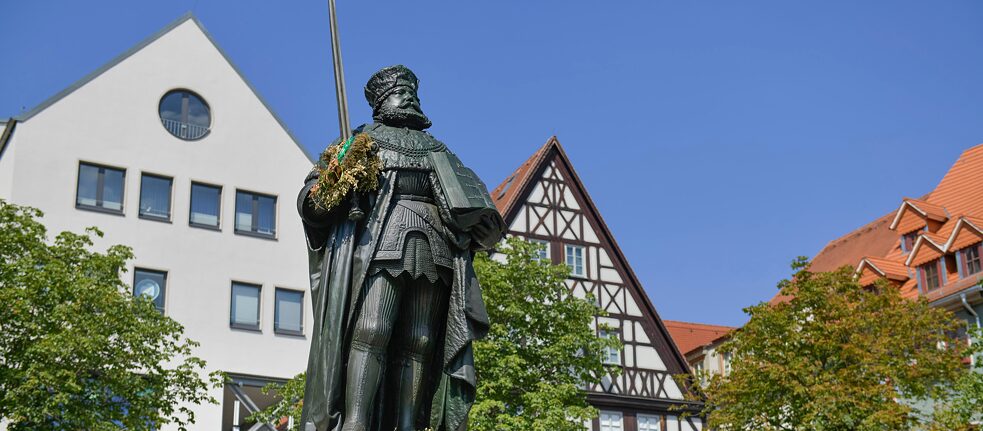 The “Hanfried” statue on Jena’s marketplace: Freshly minted PhDs use it as a target for tossed boxwood wreaths.
| Photo (detail): © picture alliance/Bildagentur-online/Schoening
The famous saying goes back to a native of Jena. Karl Victor von Hase, a 19th century German jurist, is behind the amusing anecdote. His testimony during a court hearing – he is said to have helped a friend who killed someone in a duel escape – became famous, as have many inventions from Jena. From shatterproof glass to the German flag and all sorts of influential, technical knick-knacks, a bit of everything has come out of Jena. This is probably in part because it has been a university city for centuries. Nearly 20,000 students make the city’s population young and increasingly international. All this is thanks to Johann Friedrich I of Saxony, aka the Magnanimous and “Hanfried”. After losing his old university in Wittenberg in a war, he founded the Hohe Schule in 1548 as a replacement, which became the university a few years later in 1558. His truly statuesque bronze statue now stands in all its glory on Jena’s market square and in keeping with an old custom, serves as a throwing target for the boxwood wreaths of freshly minted PhDs.
The “Hanfried” statue on Jena’s marketplace: Freshly minted PhDs use it as a target for tossed boxwood wreaths.
| Photo (detail): © picture alliance/Bildagentur-online/Schoening
The famous saying goes back to a native of Jena. Karl Victor von Hase, a 19th century German jurist, is behind the amusing anecdote. His testimony during a court hearing – he is said to have helped a friend who killed someone in a duel escape – became famous, as have many inventions from Jena. From shatterproof glass to the German flag and all sorts of influential, technical knick-knacks, a bit of everything has come out of Jena. This is probably in part because it has been a university city for centuries. Nearly 20,000 students make the city’s population young and increasingly international. All this is thanks to Johann Friedrich I of Saxony, aka the Magnanimous and “Hanfried”. After losing his old university in Wittenberg in a war, he founded the Hohe Schule in 1548 as a replacement, which became the university a few years later in 1558. His truly statuesque bronze statue now stands in all its glory on Jena’s market square and in keeping with an old custom, serves as a throwing target for the boxwood wreaths of freshly minted PhDs.
Wonders never cease
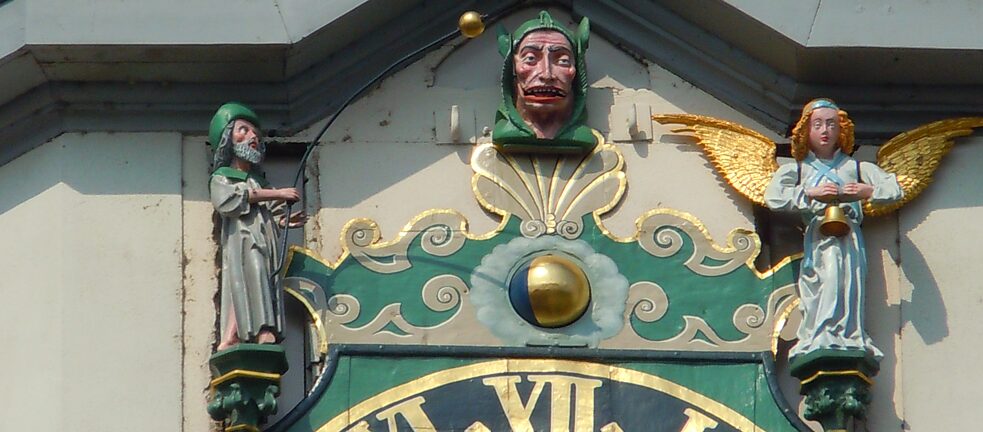 The world will end if he ever snatches the ball: The Schnapphans above the town hall clock is one of Jena’s seven wonders.
| Photo (detail): © picture alliance/Uwe Gerig
“Many a small thing has been made large by the right kind of advertising,” seems to have been the city’s marketing department’s motto as early as the 17th century, when it quickly came up with seven wonders for Jena – statues, buildings, and even a bridge. Since then, generations of Jena schoolchildren have learned the mnemonic: “Ara, Caput, Draco, Mons, Pons, Vulpecula Turris and Weigeliana Domus, septem miracula Jenae”. Weigel’s house is long gone, and the other wonders, such as the gateway at the city church or a multi-headed dragon made by students, no longer attract young people. However, the “Schnapphans” (Caput or Snatching Hans) still encourages marketplace visitors to crane their necks at the top of the hour when the scraggily wooden head right above the town hall clock tries to snatch a golden ball. To the right, a pilgrim holds the ball out to him on a long pole, while a little angel on the left rings a bell. Should the Schnapphans ever successfully snatch the ball, the world will simply end. At least that is what the legend would have us believe... A model of the Schnapphans can be seen in the entrance of the “Göhre” city museum and can be set in motion with a coin or two.
The world will end if he ever snatches the ball: The Schnapphans above the town hall clock is one of Jena’s seven wonders.
| Photo (detail): © picture alliance/Uwe Gerig
“Many a small thing has been made large by the right kind of advertising,” seems to have been the city’s marketing department’s motto as early as the 17th century, when it quickly came up with seven wonders for Jena – statues, buildings, and even a bridge. Since then, generations of Jena schoolchildren have learned the mnemonic: “Ara, Caput, Draco, Mons, Pons, Vulpecula Turris and Weigeliana Domus, septem miracula Jenae”. Weigel’s house is long gone, and the other wonders, such as the gateway at the city church or a multi-headed dragon made by students, no longer attract young people. However, the “Schnapphans” (Caput or Snatching Hans) still encourages marketplace visitors to crane their necks at the top of the hour when the scraggily wooden head right above the town hall clock tries to snatch a golden ball. To the right, a pilgrim holds the ball out to him on a long pole, while a little angel on the left rings a bell. Should the Schnapphans ever successfully snatch the ball, the world will simply end. At least that is what the legend would have us believe... A model of the Schnapphans can be seen in the entrance of the “Göhre” city museum and can be set in motion with a coin or two.
Zitterbacke and GDR barracks
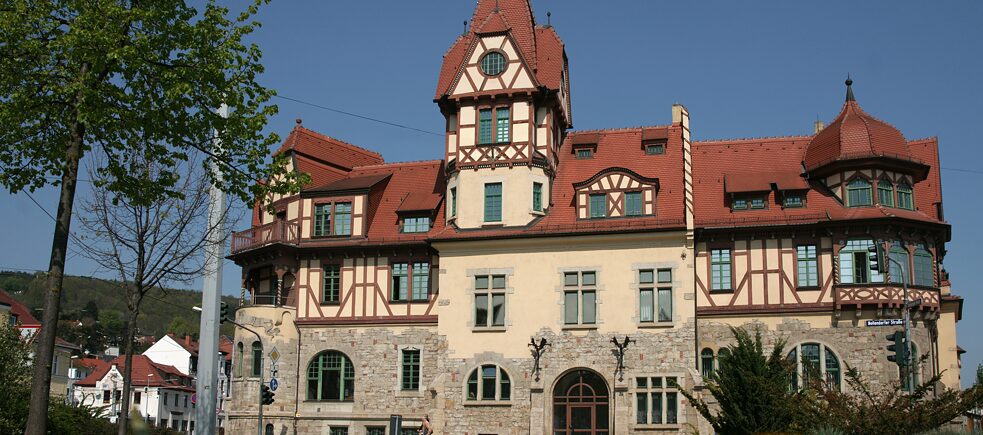 The Willhelminian and Art Deco buildings of the Damenviertel are a sharp contract to the prefab slab buildings in the north of Jena.
| Photo (detail): © picture alliance/ZB/Universität Jena
Few people who grew up in the GDR have never heard the name Alfons Zitterbacke – a classic, local hero of children’s literature – quasi the “Little Nick” of the East. The film based on the beloved book was shot for the most part in summery Jena in 1966. The footage hints at how large parts of the historic city centre had been destroyed by American air raids at the end of World War II. Another part later fell victim to socialist reconstruction plans. Today, Jena’s downtown is an architecturally colourful potpourri of socialist, historical and modern buildings – a winning mix that gives the city its charm. GDR prefabricated housing districts such as Jena Nord and Lobeda stand cheek by jowl with pre-war workmen’s houses and the Damenviertel, a stylistically cohesive Wilhelminian and Art Nouveau district. This is a place to uncover many small architectural highlights, shop organically and package free, or enjoy the sun in the Prinzessinnengarten.
The Willhelminian and Art Deco buildings of the Damenviertel are a sharp contract to the prefab slab buildings in the north of Jena.
| Photo (detail): © picture alliance/ZB/Universität Jena
Few people who grew up in the GDR have never heard the name Alfons Zitterbacke – a classic, local hero of children’s literature – quasi the “Little Nick” of the East. The film based on the beloved book was shot for the most part in summery Jena in 1966. The footage hints at how large parts of the historic city centre had been destroyed by American air raids at the end of World War II. Another part later fell victim to socialist reconstruction plans. Today, Jena’s downtown is an architecturally colourful potpourri of socialist, historical and modern buildings – a winning mix that gives the city its charm. GDR prefabricated housing districts such as Jena Nord and Lobeda stand cheek by jowl with pre-war workmen’s houses and the Damenviertel, a stylistically cohesive Wilhelminian and Art Nouveau district. This is a place to uncover many small architectural highlights, shop organically and package free, or enjoy the sun in the Prinzessinnengarten.
Trophy dreams
 The FF USV Jena women celebrate a goal against rival 1. FFC Frankfurt in 2019.
| Photo (detail): © picture alliance/Carlotta Erler
Once upon a time, in the glorious year of 1980, the great AS Rome football club came to play Carl Zeiss Jena – and went down in a whopping 0:4 defeat. FC Carl Zeiss Jena was the first team ever to manage the feat of overturning a 0:3 first leg in a European Cup match. It is games like that that turn clubs into legends. So does it even really matter that final victory was never achieved? Today, the famous Podolski quote often applies to the club: “That’s football. Sometimes the better team wins.” It is also tempting to add, at least we can still dream. In recent years, the women’s team FF USV Jena has increasingly been making them come true for the people of Jena. The football club is one of the best in Germany. More recent success stories are also being written by the boys from Science City Jena. In 2007, the German basketball club was only the second team from the new federal states to be promoted to the Basketball Bundesliga or national division.
The FF USV Jena women celebrate a goal against rival 1. FFC Frankfurt in 2019.
| Photo (detail): © picture alliance/Carlotta Erler
Once upon a time, in the glorious year of 1980, the great AS Rome football club came to play Carl Zeiss Jena – and went down in a whopping 0:4 defeat. FC Carl Zeiss Jena was the first team ever to manage the feat of overturning a 0:3 first leg in a European Cup match. It is games like that that turn clubs into legends. So does it even really matter that final victory was never achieved? Today, the famous Podolski quote often applies to the club: “That’s football. Sometimes the better team wins.” It is also tempting to add, at least we can still dream. In recent years, the women’s team FF USV Jena has increasingly been making them come true for the people of Jena. The football club is one of the best in Germany. More recent success stories are also being written by the boys from Science City Jena. In 2007, the German basketball club was only the second team from the new federal states to be promoted to the Basketball Bundesliga or national division.
Just like paradise
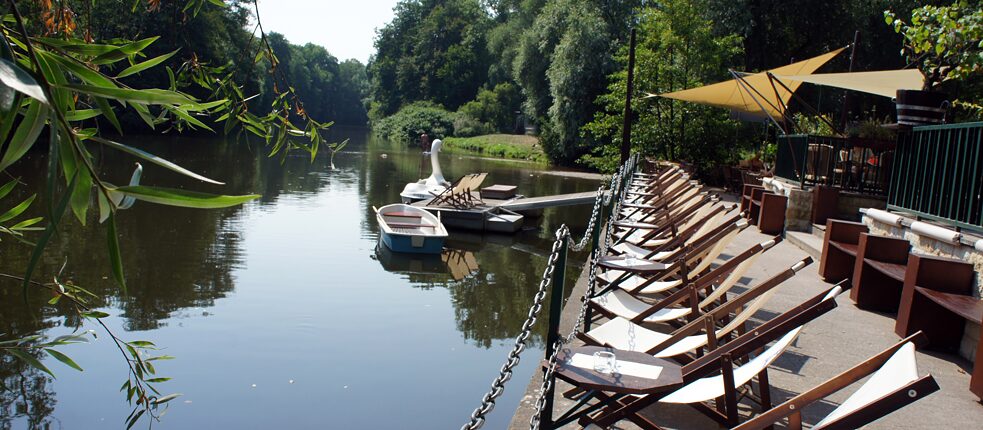 Paradise, much like the name promises.
| Photo (detail): © picture alliance/zb/Universität Jena
In Jena, the train stops in paradise. Not generally an ICE, mind, though it is a truly lovely way to arrive. Paradies is not only the name of the train station, but also the adjacent park on the River Saale, which winds like a ribbon through the park and parts of the city. Yet Paradies has little in common with those chic parks with their English golf lawns or Japanese ornamental plants. Jena’s paradise is green, somewhat overgrown, and full of people looking for the pleasant side of life. And it is not Jena’s only verdant paradise either. There is always a little bit of nature just a 15-minute walk from every corner of Jena, because the steep shell limestone slopes on the outskirts of the city are not particularly conduscive to construction. They not only make Jena incredibly green for most of the year, but also provide the city with a mild microclimate that makes some people rave rapturously about the “Tuscany of the East”.
Paradise, much like the name promises.
| Photo (detail): © picture alliance/zb/Universität Jena
In Jena, the train stops in paradise. Not generally an ICE, mind, though it is a truly lovely way to arrive. Paradies is not only the name of the train station, but also the adjacent park on the River Saale, which winds like a ribbon through the park and parts of the city. Yet Paradies has little in common with those chic parks with their English golf lawns or Japanese ornamental plants. Jena’s paradise is green, somewhat overgrown, and full of people looking for the pleasant side of life. And it is not Jena’s only verdant paradise either. There is always a little bit of nature just a 15-minute walk from every corner of Jena, because the steep shell limestone slopes on the outskirts of the city are not particularly conduscive to construction. They not only make Jena incredibly green for most of the year, but also provide the city with a mild microclimate that makes some people rave rapturously about the “Tuscany of the East”.
Comments
Comment